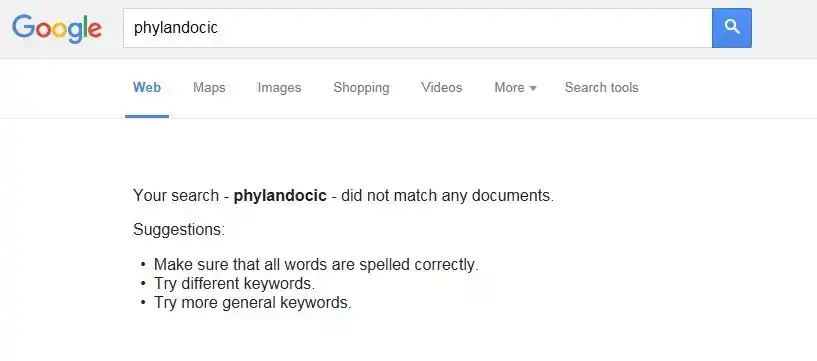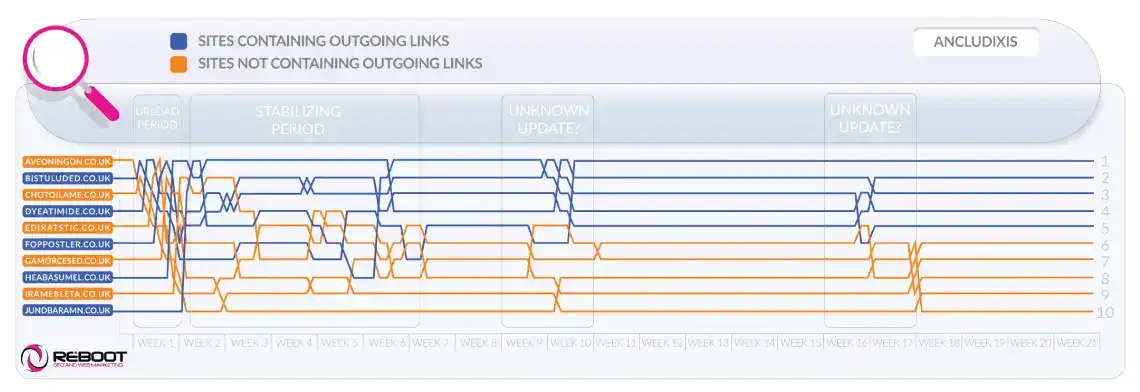
Study - Outgoing Links Used As Ranking Signal
Update: We have rerun this experiment in April 2020 using fresh domains and can confirm the same results. External links remain a ranking factor and good SEO best practice.
There are various SEO myths and fables within the online marketing community. The vast majority of which are unsubstantiated, untested and unproven. However, a recognised and commonly observed fact is that incoming links can have a positive, as well as negative effect on your website’s authority and, in turn, its ranking. What is less obvious and less tested is the effect that outgoing links can have.
I’m repeatedly astonished at the numerous times we come across the absurd and old-fashioned belief that Pagerank should be religiously kept within the site and that any outgoing links are ‘diluting’ your site’s authority (as a digital PR agency, this is something we see all too often when sharing exceptional content with webmasters and journalists. They are seemingly set on keeping Pagerank within the site, by either setting all external links to nofollow or simply not linking out to even high-quality, extremely relevant sites at all).
Reboot Online, a data-driven SEO company, has a small team of talented journalists that produce quality studies, tests, and surveys. However, at the outreach stage of the campaign, which, in essence, is all about bringing this content to the attention of influencers, we are finding that site owners are still reluctant to link out to any external sources.
There are plenty of excellent sources of information out there about why you should be referring to reputable sources so I encourage anyone reading this to spend a few minutes reading these posts. Much of the online material on this subject insinuates that apart from the obvious positive user experience that linking out will provide, it may also be an actual ranking factor for Google (see ranking factor 32). In short, they theorise that linking out to authoritative sites appropriately and in the correct context, may actually help rank your blog or website higher in Google search results.
Although many of us have been stubbornly linking out to authority sites for years now, previously there has been no actual evidence of the positive effect this may have on your site. It has always been one of those unproven ‘tactics’ that felt natural to a more progressive SEO company.
Well, we decided to plan, execute and monitor a long-term experiment that will add credence to this notion.
Hypothesis
I have found that in many cases if a rationale of algorithmic behaviour makes sense, it is often true and correct.
In this case, considering that outgoing links on your site are completely within your control, it does make sense that Google will penalise you if they believe you are participating in outgoing link schemes designed to manipulate a third party’s website's ranking. In fact, they have a whole manual penalty specifically designed for such instances.
That’s all well and true, but the one question that we know less about is whether Google's algorithms consider an outgoing, followed link, to a reputable source within the context of an article, a positive ranking signal. I, like other SEOs, always believed this to be true. If we were to try and explain the rationale behind such behaviour, it would not be too difficult. After all, we as humans make these sorts of judgments on a daily basis. Looking at people who want to befriend you as well as people who you befriend in real life, can give us a strong indicator of the sort of person you are. Reputation comes from the company you keep. Why would it be so different for websites?
It makes perfect sense that if we were an algorithm looking for patterns for calculating the authority of a person that one of those patterns would be who you associate with (i.e. link to).
Method:
The Idea we came up with is simple enough. Its execution would prove to be much more challenging. We invented a completely fake new miracle beauty compound called “Phylandocic”. This is a made-up word which is completely unknown to Google and we ensured produced no search results in the SERPS.

We created 10 sites with 300-word articles about the new product. The articles had comparable structures and text length. Keyword positions were in similar locations within the article to keep everything as consistent as possible. The number of mentions of the keywords tracked was identical across all of the sites. All sites shared equivalent code but looked slightly different via CSS changes.
5 out of the 10 sites contained 3 very high authority outgoing links to Oxford University, Cambridge University and the Genome Research Institute
The first two contained the URL as the anchor text. The third link to the Genome Research Institute contained our test phrase as the anchor.
- Oxford University points to: http://www.ox.ac.uk/
- Cambridge University points to: https://www.cam.ac.uk/
- Phylandocic points to: http://www.genome.gov/19516567
We also implanted a controlled variable test word Ancludixis in the copy, unlinked so that we could compare the results to the anchored linked test phrase Phylandocic. This phrase also returned no results in Google prior to the experiment.
The reasoning is simple. We wanted to see if the ranking increase only affects the keyword in the anchor of the outgoing link. A little like the anchor text in an incoming link would have a positive effect on that keyword in the SERPS or if the positive results from reputable outgoing links affect the content of the page as a whole. By having another test word which is not hyperlinked, we can compare to see if there is a difference in effect between the linked and the non-linked keyword.
How We Did It:
The idea is simple. We purchased 10 brand new domains and included 6 mentions of the main term which we would attempt to rank for [Phylandocic]. In each article, we mentioned 2 very highly authoritative, related websites. On 5 of the websites, mentions are in plain text whilst, on the other 5 sites, they are hyperlinked.
The 10 domains were all registered at the same time to remove any domain age influence. All domains contained 10 random but pronounceable characters and all domains were confirmed as having 0 search volume produced in Google. All sites were hosted on the same host to minimise any hosting-related bias.
- aveoningon.co.uk - No Outgoing Links
- bistuluded.co.uk - Outgoing Links
- chotoilame.co.uk - No Outgoing Links
- dyeatimide.co.uk - Outgoing Links
- edikatstic.co.uk - No Outgoing Links
- foppostler.co.uk - Outgoing Links
- gamorcesed.co.uk - No Outgoing Links
- heabasumel.co.uk - Outgoing Links
- iramebleta.co.uk - No Outgoing Links
- jundbaramn.co.uk - Outgoing Links
- All domains had all robots blocked until the content was ready and published. This ensures that the domains are not crawled by Google at substantially differing times. We fetched each one in Google in sequence. Linked, not linked, linked etc to further reduce any bias.
- All sites had non-duplicated but similar title tag structure
- Once the sites were ready, we continued in a zigzag sequence, removing the robots' restrictions and fetched through Google Web Master tools ensuring the first site to get indexed was a non-linked version and then alternating afterwards until all 10 sites were indexed. We continued with the next site once the previous had been indexed and showing in the Google index for both Site: and cache: commands.
- We searched for the key phrases and recorded results with images.
- We monitored the progress of ranking over the last 5 months.
Monitored Words:
- Phylandocic
- Ancludixis
Precautions Taken:
- We minimised all related search activities and site visits
- We ensured all activity was carried out via incognito mode.
- We did not click through Google search results whilst monitoring.
- All sites were released in a No-link, link, No-link zig-zag fashion to ensure even exposure to any variables.
- All sites were released from new IP addresses. Each IP had its own Search Console account to fetch from.
- Apart from myself and one other person within the company, no one else externally knew the actual domain or test phrases. This was done to ensure there was no contamination of data by unprotected clicks and views.
Results:
The results are clear.
Outgoing relevant links to authoritative sites are considered in the algorithms and do have a positive impact on rankings.
We completed the experiment on the 21st Feb 2016. Exactly 5 months after its initiation. The data we accumulated is substantial and one of the challenges we had was to convey it in a way that clearly showed the rate of success. We have decided to do so with two separate graphs for each key phrase.
Heat Map Graphs:
This first graph is a heat map generated using the raw data of ranking results from every single day of the test. A green square denotes that the site is in the expected position in the Google SERPS for the key phrase. A red or red gradient denotes a site is in the wrong half. The further away it is from the mid-point, the darker red the square is.
Key Phrase: [Phylandocic]
Key Phrase: [Ancludixis]
Position Graphs:
This second graph shows the position of the sites in the ranking. A Blue line denotes a site with an outgoing link while an orange line denotes a site with no outgoing links.
Key Phrase: [Phylandocic]
Key Phrase: [Ancludixis]
Interesting Notes:
Looking at the 4 graphs above, we have marked two periods as “unknown updates”. The first is during week9/week10 which is not registered with Algaroo or Mozcast but looking at the November webmasterworld thread you can clearly see some extra activity during that period (around November 19th 2015)
The second period is mentioned by Moz’s algorithm change history as Unnamed Update (January 8th).
Both those periods show turbulence in the rankings of the 10 experiment sites.
Note that none of these sites has any incoming links which would suggest both these updates may be content related.
SERPs Results:


Rank Tracker Complete Overview:
![]()
![]()
Conclusion:
The main thing to take away from this test is that although we don’t know and have not proved how powerful outgoing links are in the grand scheme of things, we have proved they do have a positive impact if used correctly.
More importantly, we disproved the old myth of Pagerank retention which in my opinion has done nothing but harm to the internet as a whole as webmasters try to keep the ‘link juice’ in-house, slowly eroding the building blocks of the web.
Link out and prosper!
Special Thanks go out to Rand Fishkin who kindly agreed to take some time out to observe the results and data prior to publishing.
* For our Dutch readers, Stefan over at SEO Professor carried out a version of this experiment himself with similar results.
Page Updated - What Has Changed?
In the interest of pursuing perfection, we have updated some aspects of this blog post to correct typos and grammatical errors, and to include updated links.




